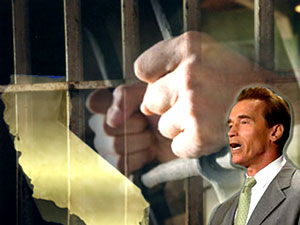- Corporate greed and private prisons (FCN, 05-01-2007)
- Critical Resistance Online (CriticalResistance.org)
- The Prison Industrial Complex: Crisis and Control (CorpWatch, 1999)
- Private Prisons for Dummies (Paul’s Justice Page)

LOS ANGELES (FinalCall.com) – California Governor Arnold Schwarzenegger passed a bill several weeks ago to help alleviate overcrowding in California’s prison system and increase public safety, but critics, who protested outside of the California State Building in Oakland May 23, argue that it amounts to more money for new cells and less for rehabilitation, leading to more recidivism and incarceration.
The demonstrators, which included East Bay residents and members of the Californians United for a Responsible Budget, were armed with a 34-foot-long petition from more than 3,300 people in prison opposing prison expansion. Their protest in part targeted Senate President pro Tem Don Perata (D-East Bay), and followed a recent L.A. protest of Assembly Speaker Fabian Nunez (D-L.A.) for denying Californians the right to vote on the $15 billion in bonds required for the additional prisons.
The demonstrators point to prison projections which indicate that by 2011, federal and state prison populations will climb by more than 192,000 new inmates. Their concerns follow outrage and a landmark hearing by State Senator Gloria Romero (D-L.A.) on the state’s secret construction of a new death chamber at San Quentin State Prison.
Assembly Bill 900 (AB900), also known as the Public Safety and Offender Rehabilitation Services Act of 2007, is a $7.7 billion bipartisan agreement, which provides for 53,000 prison and jail beds. Rehabilitation services, such as substance abuse treatment, mental health services and job training, are to accompany all new bed constructions.
Funding allocation includes $7.4 bonds/$350 General Fund to be built in two phases: Phase I allows for immediate construction; and Phase II funding depends on the California Department of Corrections and Rehabilitation’s (CDCR) ability to clear rehabilitation, management and construction benchmarks during Phase I.
This includes successfully completing construction of 12,000 new beds, 75 percent average participation in drug treatment programs over six months, establishing the California Rehabilitation Oversight Board (C-ROB) in the Office of Inspector General, increasing offender participation in classes and education programs and providing mental health day treatment for parolees.
Prison activists insist that these are “shallow promises”–not real indications of rehabilitation or sentencing reform. They are demanding that the money be spent on education, health care, housing and job training programs within the prisons.
Last year, Gov. Schwarzenegger authorized the CDCR to transfer prisoners out-of-state to help ease overcrowding, and under the bill, the legislature has authority to voluntarily or involuntarily continue the transfers for the next four years.
Skipp Townsend, founder of 2nd Call, a L.A.-based gang intervention group, believes that the plan is simply about money, not people. “There’s no comparison to the same amount being funded for a budget to educate our children. It’s about incarcerating them,” he said.
Mr. Townsend said that if the state was serious about rehabilitation, it would revamp it’s parole system, and stop violating individuals for petty offenses. “I know of two brothers, who have different fathers, but share the same mother, who were just violated because they were in a park, talking. They were picked up because both of them are on parole, however, they were doing nothing wrong,” he added.
Rose Braz, Campaign Director for Critical Resistance, national organization dedicated to opposing the expansion of the prison industrial complex, said that the history of prison construction and expansion in this state teaches better than anything that, “If you build them, you will fill them.” She said that Folsom State Prison was built in 1882 to replace an already decrepit San Quentin State Prison to relieve overcrowding, provide a better environment and services for both. “We sit here, over 100 years later, and both of those prisons are open; both of those prisons are overcrowded; both failed to provide adequate programming and services for people and the reality is that expansion is not a solution to the fact that there are too many people in California prisons,” she stated.
Ms. Braz believes that the most obvious, simplest solution is to reduce the number of people in prison, and Critical Resistance has produced a document called “Fifty Ways to Reduce the Number of People in Prison.”
“In California, we send about 60,000 people to prison every year solely for violations of parole; not for new offenses. No other state does this and if we simply put in place other ways of dealing with folks who have violated parole, we could dramatically reduce the number of people in prisons,” she stated.
Ms. Braz cited fully funding Proposition 36, the drug treatment law, and amending the Three Strikes Law as other solutions to overcrowding.
Geri Silva, executive director of Families to Amend California’s Three Strikes Law (F.A.C.T.S.), said that any time laws are made, prisons are expanded and police are added to the streets, it always means more punishment for Black, Brown and poor people, especially inner city youth.
“It’s just a given. Their plan here is not just to expand for the people who are already in there, but to expand and add prisoners. They tend to make laws so they can make prison and put people in them, to force people who are addicted into a criminal state,” Ms. Silva stated.
She said Proposition 36 was an amazing model that was under-funded to fail. “It’s just really sickening how easy it is for them to dismiss people’s lives, build more cages and put people away as if they aren’t human. But when it’s the wealthy who have drug problems, you don’t hear about them unless it’s the last resort, like Robert Downey, Jr. and Paris Hilton,” she said.












